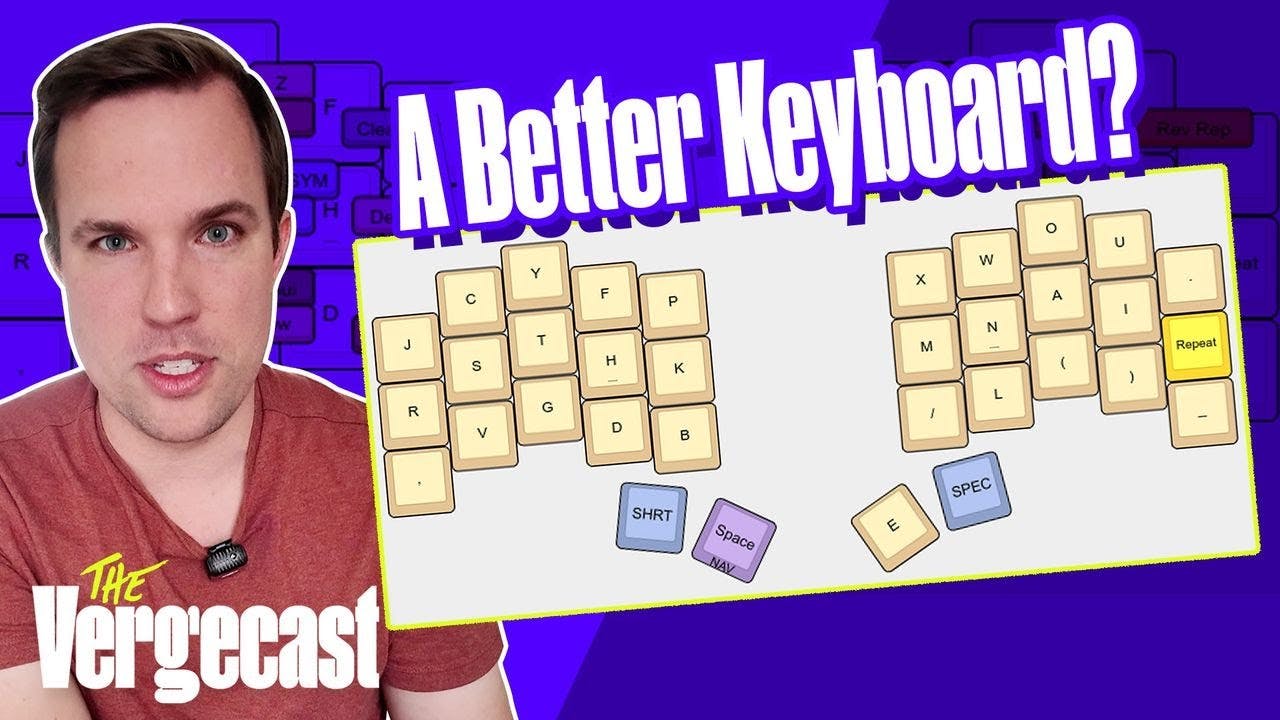A better keyboard than QWERTY | The Vergecast
()

Intro (00:00:00)
- David Pierce talks about his tech crap bag, a collection of duplicate chargers, plugs, cords, and backup headphones he keeps in his suitcase for easy travel.
- He explains how it saves him time, effort, and the hassle of forgetting essential items while traveling.
- Despite its occasional messiness, he finds the system effective and satisfying.
- The Vergecast will feature a segment on reinventing keyboard layouts.
- An individual spent two years reimagining how their keyboard functions and utilizes it.
- The story promises to be engaging and entertaining.
- Tom Warren will discuss significant changes occurring at Microsoft.
- Topics include Microsoft's plans for AI, Surface devices, and the concept of an AI PC.
- Various other subjects will also be covered.
Hotline question [N/A]
- The Vergecast will address a hotline question during the episode.
The T-34 keyboard layout (00:02:04)
- Jonas, a self-taught developer, created a custom keyboard layout to reduce repetitive strain injury (RSI) after trying ergonomic keyboards without success.
- The commonly used QWERTY keyboard layout is not necessarily the most efficient or ergonomic design, but it has become the standard due to familiarity and the difficulty of retraining.
- Alternative keyboard layouts, such as Dvorak, Colemak, Workman, and Be, aim to improve typing efficiency and reduce strain.
- Jonas focused on optimizing his layout for his specific use case and needs, prioritizing the reduction of same-finger diagrams and discomfort.
- The concept of a "repeat key" was introduced, which repeats the last pressed key, reducing same-finger presses and enabling rolling motions between keys.
- Jonas's custom layout, called T34, features multiple layers of keys accessed through modifier keys, including arrow keys, function keys, and number keys.
- Split keyboards were also recommended for ergonomic benefits.
- Overcoming muscle memory built over decades of using QWERTY keyboards is a significant challenge in adopting new layouts.
Microsoft and AI PCs w/Tom Warren (00:26:33)
- Microsoft has undergone significant changes, including corporate moves, product launches, and the hiring of Mustafa Suleyman as the CEO of Microsoft AI, signaling a shift in the company's approach to AI, Windows, and Surface.
- Panos Panay's departure from Microsoft resulted in the division of his responsibilities, with Pavan Davuluri overseeing Surface hardware and M. Parkin leading Windows engineering.
- Microsoft's reorganization placed most teams under Pavan Davuluri's leadership, consolidating Windows engineering and Surface Hardware.
- Microsoft's recent moves suggest concerns about its position in the AI race, leading to a rebranding of its AI chatbot from "ChatGPT" to "Co-pilot" and increased efforts to integrate AI into products like Office and Outlook.
- Microsoft introduced the concept of "AIPC" (Artificial Intelligence Personal Computing), requiring the latest CPUs, GPUs, and MPUs (Neural Processing Unit) for tasks like background blurring and noise cancellation.
- Microsoft's upcoming consumer-oriented Surface devices will be powered by Qualcomm Snapdragon X Elite or Elite X Arm-based processors, marking a shift from Intel-based CPUs.
- Microsoft is developing a feature called AI Explorer, which will record user activity on their PC and allow easy access to past information, leveraging the Microsoft Pluton chip for quick data retrieval.
- Concerns have been raised about the privacy implications of AI Explorer, with some opposing the idea of their screen being recorded.
Netflix recommendations tips (Vergecast Hotline) (00:52:29)
- Netflix uses various factors to recommend content, including watch history, title metadata, member preferences, and user feedback.
- The "thumbs up" and "thumbs down" rating system is designed to be simple and easy to understand.
- A "thumbs down" rating is particularly important as it helps Netflix understand what content users dislike and avoid recommending similar content in the future.
- Watching trailers and using the "remind me" button for upcoming content are strong signals of interest.
- Netflix values how much of a show or movie a user watches, with watching something to the end being a positive signal.
- Users can help improve their recommendations by creating a taste profile and rating content.